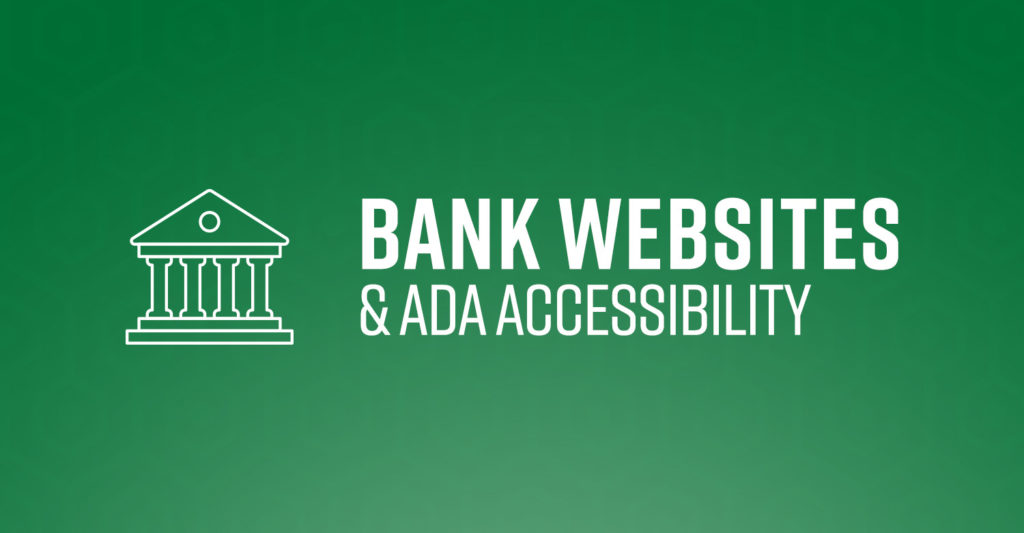One of the most common questions we get from clients new and old days is how banks, financial institutions, non-profits and other organizations can get their websites ADA-compliant.
The idea of compliance and web accessibility is nothing new, but with new proposed enforcement, many companies will soon be (or are already) taking a harder look at the topic.
Why Website Accessibility?
The United States Department of Justice will soon be releasing new Americans with Disabilities Act (or ADA) website compliance guidelines, making sure that more web designs meet the requirements.

These guidelines include simple things, from alt tags on images, to making sure your website design doesn’t use clashing colors that would make the website hard to read for those with vision impairments or colorblindness.
While web accessibility has always been important, these new guidelines will increase awareness and legal importance for some specific organizations, like banks who serve a public interest.
At Hub & Spoke, we’ve worked with several clients on Accessibility Website Audits, ensuring they’re prepared for the new guidelines, whether they’re updating an existing website or creating a new one.
The Deadline for Website Accessibility
The Department of Justice has delayed issuing updated ADA compliance regulations until 2018, but under the current administration, that may be delayed even further. Currently, regulations exist for government websites, but not for private companies. With this change, the DOJ wants any company providing public goods, such as non-profit organizations and banks, to follow the requirements.
Previously, the ADA simply released guidelines that websites could follow if they wished, but this will be the first time the compliance is mostly required (with some exceptions, of course).
Of course, it’s a good idea to follow the guidelines whether you are required to or not, so that your website reaches as many people as possible in an effective way.
The Requirements for Accessible Websites
You can find the current ADA website accessibility guidelines here. Generally speaking, these guidelines create a great path to accessibility for all.
The changes may, however, offer clarification or further guidance on how websites should comply, but the framework will remain largely the same.
The government wants websites to be correctly built so that those using disability-assistance devices like a braille tablet or a text-to-speech program will be able to easily navigate websites like their online banking portal or their medical records.
Some of the factors mentioned on the ADA website that are involved in making a site compliant and accessible to those with disabilities include making sure that every image on a site has an equivalent text description so that someone without vision knows that an image is present, and what it is.
In addition, documents need to be accessible and not only available for download in a PDF format, because that makes it harder for some people with disabilities to read it. Many PDFs are not readable by text-to-speech programs.
Other requirements include making video navigation accessible for those with disabilities and including a “skip navigation” link above your navigation menu so that those using a screen reader do not have to wait for all of your navigation to be identified before they get to the website content. These are just a few of the many things listed on the ADA site.
Why Banks will be Targeted
As the regulations get closer to the deadline, attorneys may begin to consider certain organizations targets for class action lawsuits about compliance. Now, we don’t want to use scare tactics to talk about a serious subject, but other industry trade publications have already noted this threat. At Hub & Spoke, we’ve also worked with multiple banks already on website audits and new websites that better account for ADA compliance.
Generally speaking, the reasons that banks are going to be one of the likely targets is that one, they are companies with money, and two, they are one of the primary websites that lawmakers had in mind when they decided to expand on these regulations.
Nearly everyone uses a bank of some kind.

You almost cannot survive these days using cash alone and in order to manage accounts, and according to Pew Research, more than half of the adults in this country bank online.
Banks are simply one of the biggest private sector website targets out there. For example, although nearly everyone uses a doctor, there are only a small percentage of people who actually use online web portals to access health information. In essence, being denied that service will not significantly impact their healthcare from that particular provider, partly because most providers don’t have that set up on their website anyway.
How to Make Sure Your Website Meets ADA Requirements
The best way that you can ensure that your bank or other website meets the new ADA requirements before they come up is to use a St. Louis web designer that knows how to make websites as friendly as possible to those people with disabilities.
There is a long task list of things that must be done in order to make a site compliant, and by making sure that your website is accessible to everyone – whether they are blind, deaf, are unable to use a keyboard and mouse or any other disability – will mean that you are protected.
In fact, it might be prudent to go above and beyond the requirements for websites to simply meet the requirements of the new ADA regulations.
The Consequences of Non-Compliance
You may be wondering what the consequences are for companies who do not meet these requirements and make their sites accessible to those with disabilities. If that happens they may be taken to court and have to pay a court-stipulated fee or settlement, in addition to being told to update their website.
In order for this to happen, an attorney must prove that your website falls into the category of “places of public accommodation.” These are the sites that must make changes so that they can be accessed by those with disabilities. In addition, the attorney must prove that your website is an integral part of your business or service and that being denied access actually has a detrimental effect somehow on the person with a disability.
If the court does decide in favor of the party bringing the litigation (assuming the case does indeed go to trial) you might be ordered to pay a settlement.

You will probably also be ordered to make the changes required by the ADA and you may even be given a very small window in which to make those changes. Both of these are costly consequences of non-compliance. If there is no trial, and you decide that you are going to settle, then you will still have to pay money that could have been spent getting your website up to scratch.
The bottom line here is that you should take steps as soon as possible. The new deadline may be some time in 2018, but it may take time to make the changes that your site needs and you definitely want to find a web designer that has experience with these requirements.
Wondering How This Affects You?
Have questions? Want to talk further about ADA compliance? We’re here to help. Setup a consultation today to see how it might affect your organization going forward. We’re happy to share our knowledge or to help lead a website redesign that puts you in a better position for all users.


